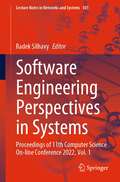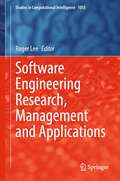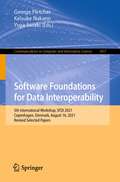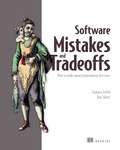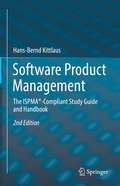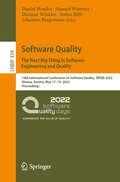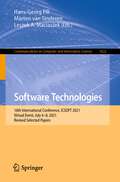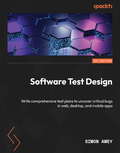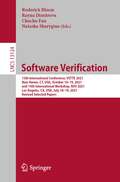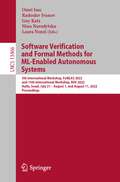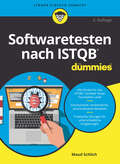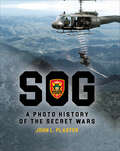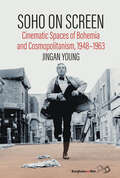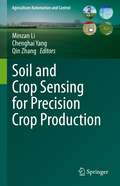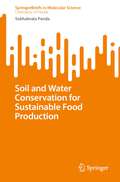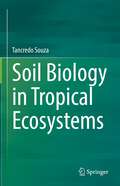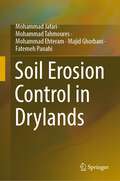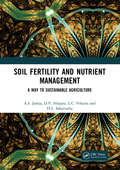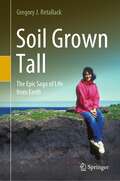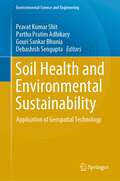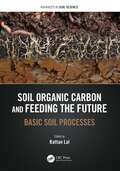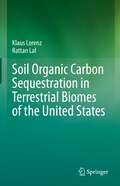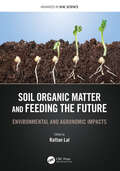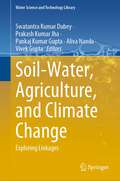- Table View
- List View
Software Engineering Perspectives in Systems: Proceedings of 11th Computer Science On-line Conference 2022, Vol. 1 (Lecture Notes in Networks and Systems #501)
by Radek SilhavyThe study of software engineering and its applications to system engineering is critical in computer science research. Modern research methodologies, as well as the use of machine and statistical learning in software engineering research, are covered in this book. This book contains the refereed proceedings of the Software Engineering Perspectives in Systems part of the 11th Computer Science On-line Conference 2022 (CSOC 2022), which was held in April 2022 online.
Software Engineering Research, Management and Applications (Studies in Computational Intelligence #1053)
by Roger LeeThis edited book presents scientific results of the 20th IEEE/ACIS International Conference on Software Engineering Research, Management, and Applications (SERA2022) held on May 25, 2022, in Las Vegas, USA. The aim of this conference was to bring together researchers and scientists, businessmen and entrepreneurs, teachers, engineers, computer users and students to discuss the numerous fields of computer science and to share their experiences and exchange new ideas and information in a meaningful way. Research results about all aspects (theory, applications and tools) of computer and information science and to discuss the practical challenges encountered along the way and the solutions adopted to solve them. The conference organizers selected the best papers from those papers accepted for presentation at the conference. The papers were chosen based on review scores submitted by members of the program committee and underwent further rigorous rounds of review. From this second round of review, 12 of the conference’s most promising papers are then published in this Springer (SCI) book and not the conference proceedings. We impatiently await the important contributions that we know these authors will bring to the field of computer and information science.
Software Foundations for Data Interoperability: 5th International Workshop, SFDI 2021, Copenhagen, Denmark, August 16, 2021, Revised Selected Papers (Communications in Computer and Information Science #1457)
by George Fletcher Keisuke Nakano Yuya SasakiThis book constitutes selected papers presented at the 5th International Workshop on Software Foundations for Data Interoperability, SFDI 2021, held in Copenhagen, Denmark, in August 2021. The 4 full papers and one short paper were thorougly reviewed and selected from 8 submissions. They present discussions in research and development in software foundations for data interoperability as well as the applications in real-world systems such as data markets.
Software Mistakes and Tradeoffs: How to make good programming decisions
by Tomasz Lelek Jon SkeetOptimize the decisions that define your code by exploring the common mistakes and intentional tradeoffs made by expert developers. In Software Mistakes and Tradeoffs you will learn how to: Reason about your systems to make intuitive and better design decisions Understand consequences and how to balance tradeoffs Pick the right library for your problem Thoroughly analyze all of your service&’s dependencies Understand delivery semantics and how they influence distributed architecture Design and execute performance tests to detect code hot paths and validate a system&’s SLA Detect and optimize hot paths in your code to focus optimization efforts on root causes Decide on a suitable data model for date/time handling to avoid common (but subtle) mistakes Reason about compatibility and versioning to prevent unexpected problems for API clients Understand tight/loose coupling and how it influences coordination of work between teams Clarify requirements until they are precise, easily implemented, and easily tested Optimize your APIs for friendly user experience Code performance versus simplicity. Delivery speed versus duplication. Flexibility versus maintainability—every decision you make in software engineering involves balancing tradeoffs. In Software Mistakes and Tradeoffs you&’ll learn from costly mistakes that Tomasz Lelek and Jon Skeet have encountered over their impressive careers. You&’ll explore real-world scenarios where poor understanding of tradeoffs lead to major problems down the road, so you can pre-empt your own mistakes with a more thoughtful approach to decision making. Learn how code duplication impacts the coupling and evolution speed of your systems, and how simple-sounding requirements can have hidden nuances with respect to date and time information. Discover how to efficiently narrow your optimization scope according to 80/20 Pareto principles, and ensure consistency in your distributed systems. You&’ll soon have built up the kind of knowledge base that only comes from years of experience. About the technology Every step in a software project involves making tradeoffs. When you&’re balancing speed, security, cost, delivery time, features, and more, reasonable design choices may prove problematic in production. The expert insights and relatable war stories in this book will help you make good choices as you design and build applications. About the book Software Mistakes and Tradeoffs explores real-world scenarios where the wrong tradeoff decisions were made and illuminates what could have been done differently. In it, authors Tomasz Lelek and Jon Skeet share wisdom based on decades of software engineering experience, including some delightfully instructive mistakes. You&’ll appreciate the specific tips and practical techniques that accompany each example, along with evergreen patterns that will change the way you approach your next projects. What's inside How to reason about your software systematically How to pick tools, libraries, and frameworks How tight and loose coupling affect team coordination Requirements that are precise, easy to implement, and easy to test About the reader For mid- and senior-level developers and architects who make decisions about software design and implementation. About the author Tomasz Lelek works daily with a wide range of production services, architectures, and JVM languages. A Google engineer and author of C# in Depth, Jon Skeet is famous for his many practical contributions to Stack Overflow.
Software Product Management: The ISPMA®-Compliant Study Guide and Handbook
by Hans-Bernd KittlausSoftware Product Management (SPM) is a key success factor for software products and software-intensive products. This book gives a comprehensive overview on SPM for beginners as well as best practices, methodology and in-depth discussions for experienced product managers. This includes product strategy, product planning, participation in strategic management activities and orchestration of the functional units of the company. The book is based on the results of the International Software Product Management Association (ISPMA®, SPM Body of Knowledge V.2) which is led by a group of SPM experts from industry and research with the goal to foster software product management excellence across industries. This book can be used as textbook for ISPMA®-based education and as guide for anybody interested in SPM as one of the most exciting and challenging disciplines in the business of software.
Software Quality: 14th International Conference on Software Quality, SWQD 2022, Vienna, Austria, May 17–19, 2022, Proceedings (Lecture Notes in Business Information Processing #439)
by Daniel Mendez Manuel Wimmer Dietmar Winkler Stefan Biffl Johannes BergsmannThis book constitutes the refereed proceedings of the 14th Software Quality Days Conference, SWQD 2022, held in Vienna, Austria, during May 17-19, 2022.The Software Quality Days (SWQD) conference started in 2009 and has grown to the biggest conference on software quality in Europe. The program of the SWQD conference is designed to encompass a stimulating mixture of practical presentations and new research topics in scientific presentations. The guiding conference topic of the SWQD 2022 is “What's The Next Big Thing in Software Engineering and Quality?”.The 4 full papers presented in this volume were carefully reviewed and selected from 8 submissions. The contributions were organized in two topical sections named: AI in Software Engineering; and Quality Assurance for Software-Intensive Systems. The book also contains two invited talks.
Software Technologies: 16th International Conference, ICSOFT 2021, Virtual Event, July 6–8, 2021, Revised Selected Papers (Communications in Computer and Information Science #1622)
by Hans-Georg Fill Marten Van Sinderen Leszek A. MaciaszekThis book constitutes the refereed proceedings of the 16th International Conference on Software Technologies, ICSOFT 2021, Virtual Event, July 6–8, 2021. The conference was held virtually due to the COVID-19 crisis.The 10 full papers included in this book were carefully reviewed and selected from 117 submissions.
Software Test Design: Write comprehensive test plans to uncover critical bugs in web, desktop, and mobile apps
by Simon AmeyA guide to writing comprehensive test plans covering exploratory testing and feature specification; black and white box testing; security, usability, and maintainability; and load and stress testingKey FeaturesCover all key forms of testing for modern applications systematicallyUnderstand anti-patterns and pitfalls in system design with the help of practical examplesLearn the strengths and weaknesses of different forms of testing and how to combine them effectivelyBook DescriptionSoftware Test Design details best practices for testing software applications and writing comprehensive test plans. Written by an expert with over twenty years of experience in the high-tech industry, this guide will provide you with training and practical examples to improve your testing skills. Thorough testing requires a thorough understanding of the functionality under test, informed by exploratory testing and described by a detailed functional specification. This book is divided into three sections, the first of which will describe how best to complete those tasks to start testing from a solid foundation. Armed with the feature specification, functional testing verifies the visible behavior of features by identifying equivalence partitions, boundary values, and other key test conditions. This section explores techniques such as black- and white-box testing, trying error cases, finding security weaknesses, improving the user experience, and how to maintain your product in the long term. The final section describes how best to test the limits of your application. How does it behave under failure conditions and can it recover? What is the maximum load it can sustain? And how does it respond when overloaded? By the end of this book, you will know how to write detailed test plans to improve the quality of your software applications.What you will learnUnderstand how to investigate new features using exploratory testingDiscover how to write clear, detailed feature specifi cationsExplore systematic test techniques such as equivalence partitioningUnderstand the strengths and weaknesses of black- and white-box testingRecognize the importance of security, usability, and maintainability testingVerify application resilience by running destructive testsRun load and stress tests to measure system performanceWho this book is forThis book is for anyone testing software projects for mobile, web, or desktop applications. That includes Dedicated QA engineers managing software quality, Test and test automation engineers writing formal test plans, Test and QA managers running teams responsible for testing, Product owners responsible for product delivery, and Developers who want to improve the testing of their code.
Software Verification: 13th International Conference, VSTTE 2021, New Haven, CT, USA, October 18–19, 2021, and 14th International Workshop, NSV 2021, Los Angeles, CA, USA, July 18–19, 2021, Revised Selected Papers (Lecture Notes in Computer Science #13124)
by Roderick Bloem Rayna Dimitrova Chuchu Fan Natasha SharyginaThis book constitutes the refereed proceedings of the 13th International Conference on Verified Software, VSTTE 2021, and the 14th International Workshop on Numerical Software Verification, NSV 2021, held online, in July/ October 2021. Due to COVID-19 pandemic the conference was held virtually.There were 10 papers presented in this volume were carefully reviewed and selected from 20 submissions. The papers focuses on challenges of the verification of cyber-physical systems with machine learning components and making large-scale verified software a practical reality and much more.
Software Verification and Formal Methods for ML-Enabled Autonomous Systems: 5th International Workshop, FoMLAS 2022, and 15th International Workshop, NSV 2022, Haifa, Israel, July 31 - August 1, and August 11, 2022, Proceedings (Lecture Notes in Computer Science #13466)
by Omri Isac Radoslav Ivanov Guy Katz Nina Narodytska Laura NenziThis book constitutes the refereed proceedings of the 5th International Workshop on Software Verification and Formal Methods for ML-Enables Autonomous Systems, FoMLAS 2022, and the 15th International Workshop on Numerical Software Verification, NSV 2022, which took place in Haifa, Israel, in July/August 2022. The volume contains 8 full papers from the FoMLAS 2022 workshop and 3 full papers from the NSV 2022 workshop. The FoMLAS workshop is dedicated to the development of novel formal methods techniques to discussing on how formal methods can be used to increase predictability, explainability, and accountability of ML-enabled autonomous systems. NSV 2022 is focusing on the challenges of the verification of cyber-physical systems with machine learning components.
Softwaretesten nach ISTQB für Dummies (Für Dummies)
by Maud SchlichSoll in Ihrem Unternehmen neue Software eingeführt werden und Sie müssen sie testen? Und Sie wissen nicht, wie Sie das angehen sollen? Oder wollen Sie als Entwickler über den Tellerrand schauen und sich auch mit dem Softwaretesten beschäftigen? Dieses Buch erläutert alle vom ISTQB® Certified Tester Foundation Level geforderten Lerninhalte sowohl für den Anwender mit Fachkenntnissen, der Software später einsetzen wird, als auch für den Programmierer. Die à bungen sind leicht in die eigene Praxis übertragbar und sorgen für eine optimale Prüfungsvorbereitung. Darüber hinaus wird für alle Testaktivitäten gezeigt, wie diese jeweils im klassischen oder im agilen Kontext aussehen.
SOG: A Photo History of the Secret Wars
by John L. PlasterA new edition of this classic illustrated history of the operations and operatives of MACV-SOG in the Vietnam War.In 1972 the U.S. military destroyed all known photos of the top-secret Studies and Observations Group, with the intention that details could never be made public. But unknown to those in charge, SOG veterans had brought back with them hundreds of photographs of SOG in action and would keep them secret for more than three decades. In this new edition of SOG: A Photo History, more than 700 irreplaceable photos bring to life the stories of SOG legends Larry Thorne, Bob Howard, Dick Meadows, George Sisler, "Q" and others, and document what really happened deep inside enemy territory: Operation Tailwind, the Son Tay raid, SOG's defense of Khe Sanh, Hatchet Force operations, Bright Light rescues, HALO insertions, string extractions, SOG's darkest programs and much more.
La soga y los ratones (El espejo del limbo #Volumen 2)
by André MalrauxSegundo volumen de memorias de André Malraux, incomparable testimonio uno de los grandes intelectuales franceses del siglo xx. En La soga y los ratones, segundo batiente de las memorias tituladas El espejo del limbo, André Malraux presenta un agudo testimonio de su tiempo a través de su increíble biografía, con particular atención a sus años de madurez. Dividido en seis partes diferenciadas, el libro repasa sus encuentros con las principales figuras contemporáneas en las esferas política y artística. Y al igual que su predecesor, Antimemorias, acaba conformando un relato originalísimo y deslumbrante, que propone una reflexión de gran calado sobre el devenir de la historia, las grandes transformaciones del siglo XX, el mal, la fraternidad, la muerte y lo único que le ofrece resistencia: la capacidad de los humanos de metamorfosearse a través del arte. Nuestra edición se completa una abarcadora introducción sobre la génesesis de la obra y una cronología de la vida del autor, ambas a cargo de Ignacio Echevarría. Sobre el autor:«Malraux se presenta como el héroe que ha sabido no morir, gracias a la última audacia de su obra».Carlos Ortega
Soho on Screen: Cinematic Spaces of Bohemia and Cosmopolitanism, 1948-1963
by Jingan YoungDespite Soho’s rich cultural history, there remains an absence of work on the depiction of the popular neighbourhood in film. Soho on Screen provides one of the first studies of Soho within postwar British cinema. Drawing upon historical, cultural and urban studies of the area, this book explores twelve films and theatrically released documentaries from a filmography of over one hundred Soho set productions. While predominantly focusing on low-budget, exploitation films which are exemplars of British and international filmmaking, Young also offers new readings of star and director biographies, from Laurence Harvey to Emeric Pressburger, and in so doing enlivens discussion on filmmaking in a time and place of intense social transformation, technological innovation and growing permissiveness.
Soil and Crop Sensing for Precision Crop Production (Agriculture Automation and Control)
by Minzan Li Chenghai Yang Qin ZhangSoil and crop sensing is a fundamental component and the first important step in precision agriculture. Unless the level of soil and crop variability is known, appropriate management decisions cannot be made and implemented. In the last few decades, various ground-based sensors have been developed to measure spatial variability in soil properties and nutrients, crop growth and yield, and pest conditions. Remote sensing as an important data collection tool has been increasingly used to map soil and crop growth variability as spatial, spectral and temporal resolutions of image data have improved significantly in recent years. While identifying spatial variability of soil and crop growth within fields is an important first step towards precision management, using that variability to formulate variable rate application plans of farming inputs such as fertilizers and pesticides is another essential step in precision agriculture.The purpose of this book is to present the historical, current and future developments of soil and crop sensing technologies with fundamentals and practical examples. The first chapter gives an overview of soil and crop sensing technologies for precision crop production. The next six chapters provide details on theories, methods, practical applications, as well as challenges and future research needs for all aspects of soil and crop sensing. The last two chapters show how soil and crop sensing technologies can be used for plant phenotyping and precision fertilization. The chapters are written by some of the world’s leading experts who have contributed significantly to the developments of precision agriculture technologies, especially in the area of soil and crop sensing. They use their knowledge, experiences, and successful stories to present informative and up-to-date information on relevant topics. Therefore, this book is an invaluable addition to the literature and can be used as a reference by scientists, engineers, practitioners, and college students for the dissemination and advancement of precision agriculture technologies for practical applications.
Soil and Water Conservation for Sustainable Food Production (SpringerBriefs in Molecular Science)
by Subhabrata PandaThis book addresses the impact of soil and water quality on food production, and explores soil and water conservation measures to be applied at farm level for agricultural sustainability. Divided into 8 chapters, the book covers topics such as soil properties responsible for soil loss, the impact of climate change, water and biological factors on soil chemistry, the effect of soil on the quality of water including sustaining aquaculture productivity and environment of wetlands, soil and water qualities necessary for irrigation, management of soil organic carbon, and the importance of soil moisture conservation including agroforestry for food production. Particular attention is given to the management of soil organic carbon in sustainable crop cultivation as well as reducing soil erosion and nutrient loss from soil from cultivated lands. The book concludes with a chapter that integrates soil and water conservation with sustainable food production and food safety.
Soil Biology in Tropical Ecosystems
by Tancredo SouzaThis textbook explores the complex nature of soil biological communities and their environments, and covers deserts, rainforests, seasonal tropical forests, dry deciduous forests, and island environments in the tropical zone. It provides essential information on soil biology concepts, ecological processes, plant-soil feedback, trophic structure, and land use effects on soil’s biological properties. The book also offers an updated approach to soil biota and microbiota and their interactions with plants that regulate the structures and functions of tropical ecosystems. Uniquely, it addresses island environments and natural disasters, shedding new light on soil organisms recovering tropical ecosystem functions. Further topics include ecological processes, plant-soil interactions, trophic communities, molecular approaches, and land use, making the book a valuable asset for students, educators and researchers engaged in the Environmental Sciences, Biodiversity and Conservation, Soil Ecology, Soil Biology, Ecology, Zoology, and Soil Biota Classification using classical and molecular tools.
Soil Erosion Control in Drylands
by Mohammad Jafari Mohammad Tahmoures Mohammad Ehteram Majid Ghorbani Fatemeh PanahiThis book focuses on drylands such as arid, semi-arid and dry sub-humid areas where they form the main part of ecosystems, e.g., in Iran, but also around the world. Mismanagement and improper exploitation of these areas lead to more degradation day by day. Besides an introduction to the role and importance of vegetation cover in conserving soil against wind and water erosion, this book gives a scope of appropriate techniques and methods for vegetation establishment and maintenance, indicators for suitable plants selection for soil conservation, and soil erosion prevention and combat. It provides methods of soil erosion prevention and combating through the application of plants, using bioengineering systems for soil erosion control and the role of agroforestry in soil erosion prevention. This book can be helpful to those with an interest in countries with similar climates to Iran. In particular, this includes Dubai, Kuwait, Saudi Arabia, Afghanistan, and Pakistan.
Soil Fertility and Nutrient Management: A Way to Sustainable Agriculture
by A.S. Jadeja D.V. Hirpara L.C. Vekaria H.L. SakarvadiaThe book entitled Soil Fertility and Nutrient Management is a compilation work and most of the information was farmed very critically covering all the main topics of plant nutrition. The book will be serve as useful reference to students, teachers, researchers scientists, policy makers and other interested in soil science, agronomy, crop science, environmental sciences and agriculture. Note: T&F does not sell or distribute the Hardback in India, Pakistan, Nepal, Bhutan, Bangladesh and Sri Lanka.
Soil Grown Tall: The Epic Saga of Life from Earth
by Gregory J. RetallackThis book is designed as an easy night's read and introduction to fossil soils and the relatively new disciplines of Paleopedology and Astropedology. It includes line art and color illustrations to visualize the topic for the informed layperson or interested colleagues. It provides comprehensive information on paleosols, which are soils of the past providing a variety of clues to the evolution of life and climate on Earth and deals with topics such as the evolution of grassland ecosystems, mass extinction of the Late Permian and origin of life, all viewed from the perspective of the fossil record of soils. This turns out to be a refreshing new perspective of wide interest.
Soil Health and Environmental Sustainability: Application of Geospatial Technology (Environmental Science and Engineering)
by Pravat Kumar Shit Partha Pratim Adhikary Gouri Sankar Bhunia Debashish SenguptaThis book demonstrates the measurement, monitoring, mapping and modelling of soil pollution and land resources. This book explores state-of-the-art techniques based on open sources software & R statistical programming and modelling in modern geo-computation techniques specifically focusing on the recent trends in data mining/machine learning techniques and robust modelling in soil resources. Soil and agricultural systems are an integral part of the global environment and human well‐being, providing multiple goods and services essential for people worldwide and crucial for sustainable development. Soil contamination is an environmental hazard and has become a big issue related to environmental health. The challenge of the twenty-first century is to reduce the contaminant load and bring it to below permissible level. The contamination is not only a problem affecting local environments at the place of occurrence but also spreading to other regions because of easy transportation of pollutants. This leads to direct and indirect contamination of land and aquatic systems, surface water and groundwater, inducing significant risks for natural ecosystems. In this context, the spatial modelling, prediction, efficient use, risk assessment, protection and management of soil resources in the agriculture system are the key to achieving sustainable development goals and ensuring the promotion of an economically, socially and environmental sustainability future. The aim of this book on soil contaminants and environmental health: application of geospatial technology is to identify the soil and sediment quality, sources of contaminants and risk assessment and focuses on the decision-making and planning point of view through GIS data management techniques. This book covers major topics such as spatial modelling in soil and sediments pollution and remediation; radioactive wastes, microbiology of soil and sediments, soil salinity and sodicity, pollution from landfill sites, soil erosion and contamination from agricultural activities, heavy metal pollution and health risk; environmental impact and risk assessment, sustainable land use, landscape management and governance, soil degradation and risk assessment, agricultural soil pollution, pollution due to urban activities, soil pollution by industrial effluents and solid wastes, pollution control and mitigation in extreme environments. The content of this book is of interest to researchers, professionals and policy-makers whose work is in soil science and agriculture practices. The book equips with the knowledge and skills to tackle a wide range of issues manifested in geographic data, including those with scientific, societal and environmental implications.
Soil Organic Carbon and Feeding the Future: Basic Soil Processes (Advances in Soil Science)
by Rattan LalSoil organic matter (SOM) is a highly reactive constituent of the soil matrix because of its large surface area, high ion exchange capacity, enormous affinity for water due to hygroscopicity, and capacity to form organo-mineral complexes. It is an important source and sink of atmospheric CO2 and other greenhouse gases depending on climate, land use, soil and crop management, and a wide range of abiotic and biotic factors, including the human dimensions of socioeconomic and political factors. Agroecosystems are among important controls of the global carbon cycle with a strong impact on anthropogenic or abrupt climate change. This volume of Advances in Soil Sciences explains pedological processes set-in-motion by increases in SOM content of depleted and degraded soils. It discusses the relationship between SOM content and critical soil quality parameters including aggregation, water retention and transport, aeration and gaseous exchange, and chemical composition of soil air. The book identifies policy options needed to translate science into action for making sustainable management of SOM as a strategy for adaptation to and mitigation of climate change. Features: Relates soil organic matter stock to soil processes, climate parameters, vegetation, landscape attributes Establishes relationships between soil organic matter and land use, species, and climate Identifies land use systems for protecting and restoring soil organic matter stock Links soil organic matter stock with the global carbon cycle for mitigation of climate change Part of the Advances in Soil Sciences series, this volume will appeal to agricultural, environmental, and soil scientists demonstrating the link between soil organic matter stock and provisioning of critical ecosystem services for nature and humans.
Soil Organic Carbon Sequestration in Terrestrial Biomes of the United States
by Klaus Lorenz Rattan LalThis book collates, reviews and synthesizes information on how soil organic carbon (SOC) stocks differ among major terrestrial biomes of the U.S.A. Information on soil inorganic carbon (SIC) stocks for different terrestrial biomes of the U.S.A. will also be presented. The book deliberates options for increasing SOC stocks and enhancing SOC sequestration in terrestrial biomes by soil and land-use management practices. It concludes with an overview of terrestrial biomes of the U.S.A. where targeted soil and land-use management practices may result in the greatest increases in SOC stocks and enhancements in SOC sequestration.
Soil Organic Matter and Feeding the Future: Environmental and Agronomic Impacts (Advances in Soil Science)
by Rattan LalSoil organic matter (SOM) is the primary determinant of soil functionality. Soil organic carbon (SOC) accounts for 50% of the SOM content, accompanied by nitrogen, phosphorus, and a range of macro and micro elements. As a dynamic component, SOM is a source of numerous ecosystem services critical to human well-being and nature conservancy. Important among these goods and services generated by SOM include moderation of climate as a source or sink of atmospheric CO2 and other greenhouse gases, storage and purification of water, a source of energy and habitat for biota (macro, meso, and micro-organisms), a medium for plant growth, cycling of elements (N, P, S, etc.), and generation of net primary productivity (NPP). The quality and quantity of NPP has direct impacts on the food and nutritional security of the growing and increasingly affluent human population. Soils of agroecosystems are depleted of their SOC reserves in comparison with those of natural ecosystems. The magnitude of depletion depends on land use and the type and severity of degradation. Soils prone to accelerated erosion can be strongly depleted of their SOC reserves, especially those in the surface layer. Therefore, conservation through restorative land use and adoption of recommended management practices to create a positive soil-ecosystem carbon budget can increase carbon stock and soil health. This volume of Advances in Soil Sciences aims to accomplish the following: Present impacts of land use and soil management on SOC dynamics Discuss effects of SOC levels on agronomic productivity and use efficiency of inputs Detail potential of soil management on the rate and cumulative amount of carbon sequestration in relation to land use and soil/crop management Deliberate the cause-effect relationship between SOC content and provisioning of some ecosystem services Relate soil organic carbon stock to soil properties and processes Establish the relationship between soil organic carbon stock with land and climate Identify controls of making soil organic carbon stock as a source or sink of CO2 Connect soil organic carbon and carbon sequestration for climate mitigation and adaptation
Soil-Water, Agriculture, and Climate Change: Exploring Linkages (Water Science and Technology Library #113)
by Swatantra Kumar Dubey Prakash Kumar Jha Pankaj Kumar Gupta Aliva Nanda Vivek GuptaThis book presents an exploration of linkages among soil-water, agriculture, and climate change with a special focus on thematic areas for assessment, mitigation, and management of natural resources under climate change conditions. This book covers advances in modelling approaches, including machine learning (ML)/ artificial intelligence (AI) applications; GIS and remote sensing; sensors; impacts of climate change on agriculture; subsurface water; contaminants; and socio-economic impacts, which are lacking in a more comprehensive manner in the previous titles. This book encompasses updated information as well as future directions for researchers working in the field of management of natural resources. The goal of this book is to provide scientific evidence to researchers and policymakers and end-to-end value chain practitioners which may help in reducing the overall adverse impacts of climate change on water resources and the related mitigation strategies. This book focuses on the knowledge, modern tools, and techniques, i.e., machine learning, artificial intelligence, etc. for soil-water, agriculture, and climate change. Further, nature-based solutions for management of natural resources with special targets on contaminants, extreme events, disturbances, etc. will be targeted. The book provides readers with the enhanced knowledge for application of engineering principles and economic and regulatory constraints to determine a soil-water, agriculture production action strategy, and select appropriate technologies to implement the strategy for a given data set at a site. It would also cover the application of laboratory, modeling, numerical methods for determination and forecasting of climate change impacts, agriculture production, pollution, soil health, etc. Overall, it provides hydrologists, environmental engineers, administrators, policy makers, consultants, and industrial experts with essential support in effective management of soils health, agricultural productions, and mitigation of extreme climatic events.
